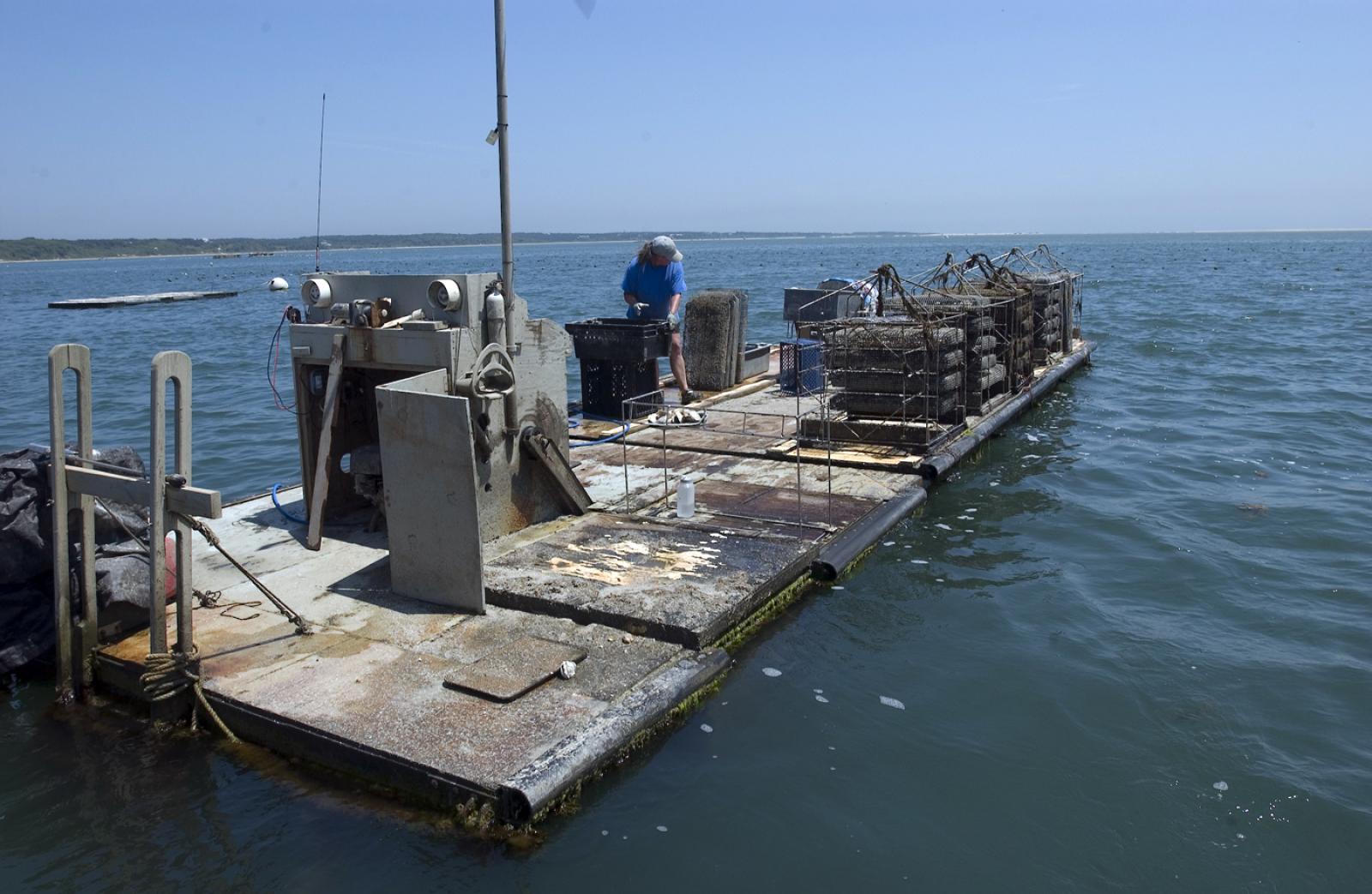The oysters are growing like proverbial weeds in Katama Bay this summer.
Jack Blake and his wife Sue of Sweet Neck Farm Oysters said their crop of cultured bivalves is three weeks ahead of last year’s crop. “The water temperature in Katama Bay is 75 degrees now. Last year at this time it was 68. Oysters love warm water,” Mr. Blake said.
Demand is up too. Twice a week, Mr. Blake ships oysters by plane to Nantucket, where they are served in at least six restaurants; on top of that he is keeping all his Island customers happy too. Mr. Blake said Island oyster growers are doing well in what has been an expanding industry over the past 15 years.
This year the town of Edgartown gave leases to two new oyster farmers in the bay: Jason Bennett and Sandy Fisher. There are now 10 growers in Katama and one in Cape Pogue Pond. The selectmen have no plan to expand that number.
Raising cultured oysters has opened the door wide for entrepreneurial fishermen looking for income. Twenty years ago, local oysters were consumed and shipped off-Island in the winter but there were none available in the summer. Back then, the lore was you never ate a local oyster during any month that did not have the letter “r” in it. Restaurants and local fish markets that wanted to sell oysters in the summer had to import them.
Now cultured oysters from the Vineyard are served year-round, partly thanks to a surge of interest in aquaculture.
The hard part was getting the business started. In 1995, the Martha’s Vineyard Shellfish Group trained a group of fishermen in aquaculture, and Mr. Blake was one of the first to try. “I didn’t make a dime in the first four years,” he said. Now oyster farming is his only business and a 12-month-a-year job. “I think a farmer starting out now can start making money in two years,” said Mr. Blake, who is widely looked up to as the best example of success in oyster growing.
He said he believes about three million oyster seed are being cultivated in Katama Bay this summer. Not all of those oysters will survive; Mr. Blake estimates that about half will make it to market. “Years vary,” he said. He said about 40 per cent of his oysters survived in 2009, while 75 per cent survived in 2008. Like farming on the land, a wide variety of factors affect a crop. “A key factor is that we try hard to take care of them,” Mr. Blake said.
It takes three years for a wild oyster to reach a legal harvestable size, if it survives that long, while it can take about 15 months for a cultured oyster to reach harvestable size. The better-sized and more desirable oysters may take a good two years.
Mr. Blake said most of the oyster farmers got their seed from Maine back in June. At the time, the juvenile shellfish were small enough to slip through a window screen. Now they are as big as the nail on your little finger and growing fast.
And while wild oysters grow in the brackish Edgartown and Tisbury Great Ponds, cultured oysters can be raised in saltwater in places they normally wouldn’t be found, including Menemsha Pond, Cape Pogue and Katama Bay. As he tends his oysters, Mr. Blake can see the ocean opening at the end of the bay, where large ocean rollers are coming in. Mr. Blake has his youngest oysters growing in an upweller, a floating raft that sits at a mooring. Currents moving through the bay pour all kinds of nutrients onto the oysters, feeding them just what they want to eat. And so far, the season ahead looks great.
Looking across the bay, Mr. Blake said, “There are a lot of families in this business now.” He said Roy Scheffer and his family are working their oyster farm, and not far away, Mr. Blake points out Mr. Castro working on his float with his son Adam. Ryan Smith is an oyster grower; his father is a commercial fisherman.
Louis Larsen of the Net Result fish market in Vineyard Haven has high praise for the oysters being raised by Island fishermen and also for Mr. Blake, who is seen as a leader in his field.
Mr. Larsen said he buys his oysters from Ryan Smith; he may buy as many as 5,000 to 7,000 oysters a week during the summer. Mr. Smith’s product is named Signature Oysters.
And Island oyster growers have learned much about marketing in the past decade, beginning with the need to take care of their local markets first, which depend on a reliable source.
Cultured oysters from this region have developed a large following. Mr. Blake said he focuses on local markets in the summer and ships all his oysters to Boston in the winter. From Boston, the oysters are shipped all over the country.
The Gulf oil disaster has increased the value of oysters. “It has made the price of the Chesapeake Bay oyster triple,” Mr. Larsen said.
And it is not just about providing something good for the table. “People know that oysters are good for water quality. Oysters are filter feeders; one oyster filters 30 times more water than a clam,” Mr. Larsen said.
Edgartown harbor master Charlie Blair counts himself among the many admirers of Mr. Blake. “Jack Blake has helped and trained everybody in the business,” Mr. Blair said. “The town supports the oyster farmers. The town doesn’t charge them a fee for their moorings, where they keep their upwellers, which is a big deal. We’ve even kept an area of the Narrows open just for the upwellers,” he added.
“They need every break we can give them.”




Comments
Comment policy »